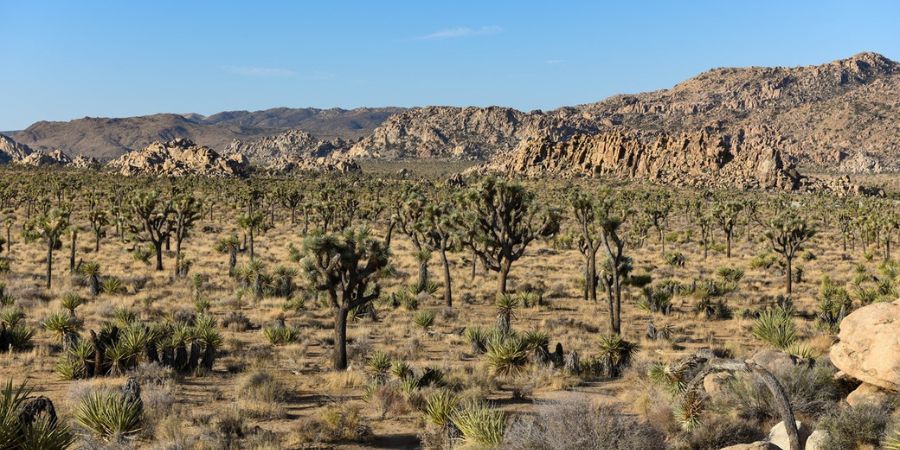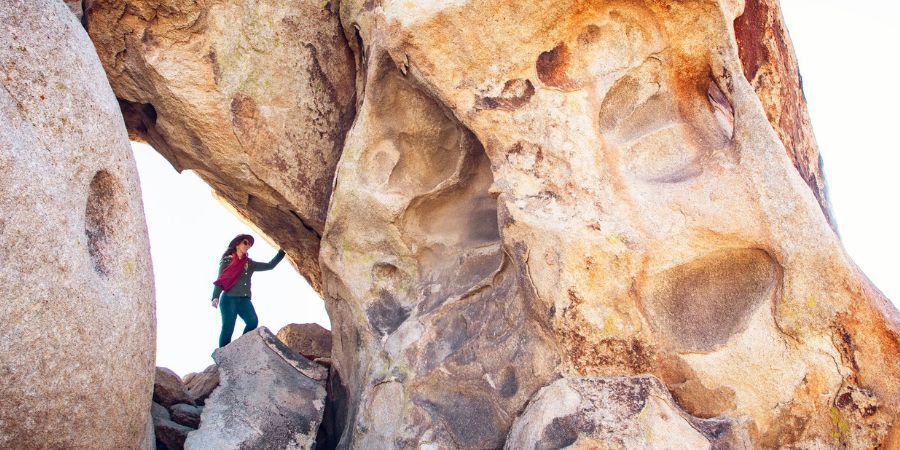Exploring the Wonders of Joshua Tree National Park
June 17, 2024
Discover the Park’s Unique Trees, Climbing Spots, and Stargazing Marvels
Joshua Tree National Park, located in southeastern California, is a mesmerizing blend of natural beauty, geological marvels, and rich cultural history. This iconic park, known for its distinctive Joshua trees and otherworldly landscapes, offers an unforgettable experience for nature enthusiasts and adventurers alike. In this blog post, we'll delve into the many facets that make
Joshua Tree National Park an extraordinary destination.

The Enigmatic Joshua Trees
Joshua Tree National Park is named after the Joshua tree (Yucca brevifolia), a unique and striking plant native to the Mojave Desert. These trees, with their twisted, spiky branches and unusual silhouettes, create a surreal and enchanting landscape. According to legend, Mormon settlers named the tree after the biblical figure Joshua, as its outstretched branches reminded them of Joshua's hands reaching up to the sky in prayer. The Joshua trees not only define the park's aesthetic but also play a crucial role in the desert ecosystem, providing habitat and food for numerous species.
Geological Marvels
The park's dramatic geological formations are a testament to the power of natural forces over millions of years. Rugged mountains, exposed granite monoliths, and unique rock formations dominate the landscape. One of the most famous formations is Skull Rock, which resembles a human skull and is a favorite spot for photographers and hikers. The Wonderland of Rocks is another must-visit area, offering a labyrinth of massive boulders and rock piles that attract climbers and adventurers from around the globe.
Rich Biodiversity
Despite its arid environment, Joshua Tree National Park is home to a surprisingly diverse array of flora and fauna. The park's ecosystems support a variety of plant life, including creosote bushes, Mojave yuccas, and cholla cacti. Wildlife enthusiasts can spot desert tortoises, bighorn sheep, and a wide range of bird species, such as the roadrunner and the red-tailed hawk. The park's diverse habitats, from sandy basins to rocky hillsides, provide a haven for these resilient creatures.
Stargazing Paradise
One of Joshua Tree's most magical features is its dark skies, making it a premier destination for stargazing. The park's remote location and minimal light pollution allow for breathtaking views of the Milky Way, constellations, and other celestial wonders. Visitors can experience the awe-inspiring beauty of the night sky, whether through guided programs, star parties, or simply lying back and gazing up at the stars.
Cultural History
Joshua Tree National Park has a rich cultural history, with evidence of Native American habitation dating back thousands of years. The park is home to numerous archaeological sites, including petroglyphs and pictographs created by the Serrano, Cahuilla, and Chemehuevi peoples. These ancient rock art sites offer a glimpse into the lives and spiritual practices of the park's earliest inhabitants. Additionally, remnants of early mining operations and homesteads provide insight into the region's more recent history.

Outdoor Recreation
Joshua Tree offers a plethora of outdoor activities for visitors of all interests and skill levels. The park's diverse landscapes provide a perfect backdrop for various recreational pursuits.
Rock Climbing
Joshua Tree is renowned as one of the top rock climbing destinations in the world. With over 8,000 established climbing routes, the park caters to climbers of all abilities. The granite monoliths and boulder piles offer a range of climbing experiences, from traditional crack climbing to challenging sport routes. Popular climbing areas include Hidden Valley, Intersection Rock, and Echo Cove. Whether you're a seasoned climber or a beginner looking to take a class, Joshua Tree's climbing community is welcoming and vibrant.
Hiking
The park boasts an extensive network of hiking trails that traverse its diverse terrain. Some of the most popular trails include:
- Hidden Valley: A 1-mile loop that takes hikers through a scenic, boulder-strewn valley, offering glimpses of unique rock formations and desert flora.
- Ryan Mountain: A 3-mile round-trip hike that ascends to the summit of Ryan Mountain, providing panoramic views of the park's rugged landscape.
- Barker Dam: A 1.3-mile loop that leads to a historic water reservoir, built by early cattle ranchers, and offers opportunities to see wildlife and ancient petroglyphs.
- Lost Horse Mine: A 4-mile round-trip hike to one of the best-preserved gold mines in the park, offering a glimpse into the area's mining history and spectacular views.
Camping
Joshua Tree offers a range of camping options, from developed campgrounds with amenities to remote backcountry sites for a more rugged experience. Popular campgrounds include:
- Jumbo Rocks: Known for its proximity to large boulder formations, making it a favorite among climbers and photographers.
- Black Rock: Located near the park's western entrance, offering easy access to hiking trails and horseback riding opportunities.
- Cottonwood: Situated in the southern part of the park, providing a quieter, more secluded camping experience.
Backpacking
For those seeking solitude and adventure, Joshua Tree's vast backcountry offers numerous opportunities for multi-day backpacking trips. The park's wilderness areas, such as the Pinto Basin and the Wonderland of Rocks, provide a chance to explore remote and pristine desert landscapes. Backpackers must be self-sufficient and prepared for the challenges of desert travel, including limited water sources and extreme temperatures.
Bouldering
Joshua Tree is a bouldering paradise, with countless problems ranging from beginner to expert levels. Areas like Joshua Tree's "Real Hidden Valley" and "The Outback" offer concentrated clusters of boulders, making it easy to sample multiple problems in a single session. Bouldering pads and spotters are essential for safety.
Horseback Riding
The park's equestrian trails offer a unique way to experience Joshua Tree's landscapes. Riders can explore trails such as the California Riding and Hiking Trail, which traverses a variety of desert environments. Horseback riding provides a peaceful and immersive way to connect with the natural beauty of the park.
Photography
Joshua Tree's stunning scenery and unique light conditions make it a haven for photographers. From sunrise to sunset, the park offers endless opportunities for capturing dramatic landscapes, intriguing plant life, and the vibrant night sky. Iconic locations like Arch Rock and Keys View are popular spots for photographers looking to capture the essence of Joshua Tree.
The Convergence of Two Deserts
One of the unique aspects of Joshua Tree National Park is its location at the intersection of two distinct desert ecosystems: the Mojave and the Colorado Deserts. The Mojave Desert, found in the western part of the park, is characterized by its higher elevation and iconic Joshua trees. In contrast, the Colorado Desert, located in the eastern portion of the park, features lower elevations, hotter temperatures, and a different array of plant and animal life. This convergence of ecosystems results in a remarkable diversity of landscapes and species within the park.
Inspiration for Artists
The stark beauty and unique atmosphere of Joshua Tree have long inspired artists, musicians, and writers. The park has a strong association with the music scene, particularly rock and folk genres. Musicians such as U2, who named their famous album "The Joshua Tree" after the park, and Gram Parsons, who spent time in the area, have found inspiration in its landscapes. The park's ethereal quality and serene environment continue to draw creative minds seeking solitude and inspiration.
Varied Climate
The climate in Joshua Tree National Park varies significantly, contributing to the park's diverse environments. Summers are hot, with temperatures often exceeding 100°F (38°C), while winters are mild and can occasionally bring snowfall to higher elevations. The weather can change rapidly, adding an element of unpredictability to the experience. Visitors should be prepared for varying conditions and bring appropriate gear for their activities.
Visitor Centers and Resources
Joshua Tree National Park has several visitor centers that enhance the visitor experience by providing educational exhibits, park information, and resources for planning a visit. The Joshua Tree Visitor Center, the Oasis Visitor Center, and the Cottonwood Visitor Center offer exhibits on the park's natural and cultural history, maps, and ranger-led programs. These centers are valuable resources for learning about the park's unique features and ensuring a safe and enjoyable visit.
Joshua Tree National Park is a captivating destination that offers a unique blend of natural beauty, geological wonders, and cultural richness. Whether you're a nature enthusiast, an adventure seeker, or an artist in search of inspiration, Joshua Tree has something to offer. The park's enigmatic Joshua trees, dramatic rock formations, diverse wildlife, and dark skies create an unforgettable experience that will leave you in awe of the natural world. Plan your visit to
Joshua Tree National Park and discover the magic of this extraordinary desert landscape.
What is the best time of year to visit Joshua Tree National Park?
The best time to visit Joshua Tree National Park is during the fall (October to November) and spring (March to April). During these seasons, temperatures are milder, making outdoor activities more enjoyable. Summer temperatures can be extremely hot, while winter nights can be quite cold, although daytime temperatures are usually pleasant.
What are the must-see attractions in Joshua Tree National Park?
Some must-see attractions in Joshua Tree National Park include:
- The iconic Joshua trees found throughout the park.
- Skull Rock, a unique rock formation resembling a human skull.
- Hidden Valley, a scenic area ideal for hiking and rock climbing.
- Keys View, which offers panoramic views of the Coachella Valley.
- Barker Dam, a historic water reservoir with opportunities to see wildlife and ancient petroglyphs.
Are there any safety tips for visiting Joshua Tree National Park?
Yes, safety tips for visiting Joshua Tree National Park include:
- Carry plenty of water, especially during hot weather.
- Dress in layers to prepare for temperature changes.
- Wear sturdy shoes for hiking and exploring rocky terrain.
- Be aware of wildlife, including snakes and scorpions.
- Let someone know your itinerary if hiking or camping in remote areas.
- Follow Leave No Trace principles to preserve the park's natural beauty.
Can I camp anywhere in Joshua Tree National Park?
Camping is allowed in designated campgrounds and backcountry areas with a permit. Popular campgrounds include Jumbo Rocks, Black Rock, and Cottonwood. Backcountry camping requires registration at one of the park's backcountry registration boards. Dispersed camping outside of designated areas is not permitted to protect the park's fragile ecosystem.
What activities are available for families visiting Joshua Tree National Park?
Joshua Tree National Park offers several family-friendly activities, such as:
- Easy hikes like the Barker Dam Trail and Hidden Valley Trail.
- Ranger-led programs and educational exhibits at the visitor centers.
- Stargazing and participating in astronomy events.
- Picnicking at designated areas with scenic views.
- Exploring the park's rock formations and enjoying nature photography.
Check out the latest guides on hiking gear
Check out the latest guides on camping gear
Author: William Flaiz










